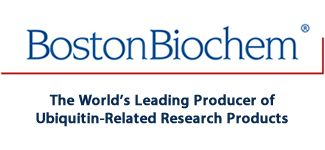
Recombinant Human His6-PolyUb WT Chains (2-7,K48-linked), CF Summary
19 kDa (Ub2), 29 kDa (Ub3), 38 kDa (Ub4), 48 kDa (Ub5), 58 kDa (Ub6), and 67 kDa (Ub7)
Product Datasheets
Carrier Free
CF stands for Carrier Free (CF). We typically add Bovine Serum Albumin (BSA) as a carrier protein to our recombinant proteins.Adding a carrier protein enhances protein stability, increases shelf-life, and allows the recombinant protein to be stored at a more dilute concentration.The carrier free version does not contain BSA.
In general, we advise purchasing the recombinant protein with BSA for use in cell or tissue culture, or as an ELISA standard.In contrast, the carrier free protein is recommended for applications, in which the presence of BSA could interfere.
UCH-230
| Formulation | Lyophilized from a solution in deionized water. |
| Reconstitution | Reconstitute atup to 5mg/mL in an aqueous solution. |
| Shipping | The product is shipped at ambient temperature. Upon receipt, store it immediately at the temperature recommended below. |
| Stability & Storage: | Use a manual defrost freezer and avoid repeated freeze-thaw cycles.
|
Reconstitution Calculator
Background: Poly-Ubiquitin
Poly-Ubiquitin chains are composed of Ubiquitin monomers that are covalently linked through isopeptide bonds, which typically form between a lysine residue of one Ubiquitin molecule and the C-terminal glycine residue of another Ubiquitin molecule (1). Each human Ubiquitin monomer is 76 amino acids (aa) in length and shares 96% and 100% aa identity with yeast and mouse Ubiquitin, respectively (2). Seven of the 76 aa in Ubiquitin are lysine residues that can participate in poly-Ubiquitin chain formation. Linkage through specific lysine residues is thought to serve as a signal that affects protein degradation, signaling, trafficking, and other cellular processes (3-8).
Linkage specific poly-Ubiquitin chains are used to investigate mechanisms of chain recognition, binding and hydrolysis by the proteasome, deubiquitinating enzymes, E3 ligases or other proteins that contain ubiquitin-associated domains (UBAs) or ubiquitin-interacting motifs (UIMs). Lys48-linked chains are abundant in vivo and act as a universal signal for proteasomal degradation. This product is formed with His6-tagged wild-type human recombinant Ubiquitin and linkage-specific enzymes. This mixture of poly-Ubiquitin chains contains di-Ubiquitin and higher MW species; mono-Ubiquitin has been removed. The His6-tag is convenient for metal chelate affinity purification and immuno-detection using His6-specific antibodies.
- Scheffner, M. et al. (1995) Nature 373:81.
- Sharp, P.M. & W.-H. Li (1987) Trends Ecol. Evol. 2:328.
- Behrends, C. & J.W. Harper (2011) Nat. Struct. Mol. Biol. 18:520.
- Greene, W. et al. (2012) PLoS Pathog. 8:e1002703.
- Henry, A.G. et al. (2012) Dev. Cell 23:519.
- Tong, X. et al. (2012) J. Biol. Chem. 287:25280.
- Wei, W. et al. (2004) Nature 428:194.
- Zhang, J. et al. (2012) J. Biol. Chem. 287:28646.
FAQs
No product specific FAQs exist for this product, however you may
View all Proteins and Enzyme FAQsReconstitution Buffers
Reconstitution Buffer 1 (PBS)
Reviews for Recombinant Human His6-PolyUb WT Chains (2-7,K48-linked), CF
There are currently no reviews for this product. Be the first toreview Recombinant Human His6-PolyUb WT Chains (2-7,K48-linked), CF and earn rewards!
Have you used Recombinant Human His6-PolyUb WT Chains (2-7,K48-linked), CF?
Submit a review and receive an Amazon gift card.
$25/€18/£15/$25CAN/¥75 Yuan/¥1250 Yen for a review with an image
$10/€7/£6/$10 CAD/¥70 Yuan/¥1110 Yen for a review without an image
ebiomall.com






>
>
>
>
>
>
>
>
>
>
>
>
Blood lipid Standards
1.我知道一般缺省域值是3-15个循环荧光强度的标准方差的10倍,但是为什么公式是10×SD(6-15)?那仪器的本底荧光强度是前15个循环的荧光强度就算是baseline,那么仪器中用域值分析和用baseline分析有什么不同?域值能否改动?改动后的结果对于后续的分析有什么影响?一般什么时候需要改动?
2.所谓读板温度是不是就是每一部反应后检测荧光强度的步骤?是不是可以任意设定在某一步骤?譬如变性,退火,延伸甚至自己设定一个温度?
3.在做标准曲线的时候,对于标准品的要求是不是一般要求就是待扩增的目的片断,便于以后的扩增效率可比性?是不是这个也是购买的绝对标准品进行曲线作图的缺陷之一,虽然其绝对的定量已知?
4.在相对定量时候,如果内参和目的基因在同一管中进行扩增就是内参照法?不同管就是外参照法?是不是不太赞成内参照法,因为无法预知目的基因起始浓度,从而可能导致内参扩增效率远远大于目的基因而无法使用2-△△CT方法分析?
5.融解曲线的导出是不是在反应结束以后进行?融解曲线出现主峰异常增宽是什么原因导致?我还是不明白探针法是如何得出融解曲线的,主要是原理,因为染料法就是升高温度双链解链染料脱离?
6.如果用荧光染料方法进行试验,出现引物二具体很多,那么在NTC和加入模板的溶解曲线中dimer的峰值和模板中的峰值是否重叠?
敬请指教!非常感谢!
既说像坐标画曲线曲线应纵轴该荧光强度吧轴数值变化代表荧光强度变化荧光强度变化代表钙离浓度变化 我觉直接用荧光强度值变化代替钙离浓度变化研究意义该钙离浓度变化吧
非要荧光强度值换算钙离浓度需要做列工作
1 取标准钙离浓度染色用共聚焦显微镜测荧光强度
2 标准品需要同像环境主要曝光间相同激光波及能量
3 标准品要用同浓度荧光染料
才能根据标准荧光强度关系推算品钙离浓度









